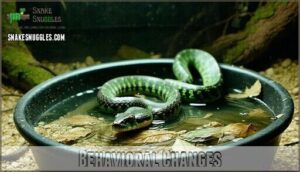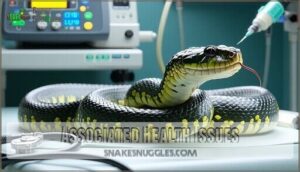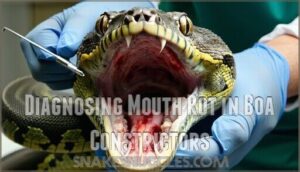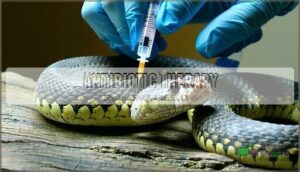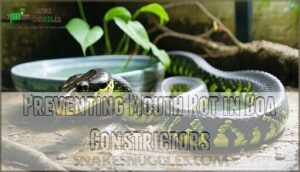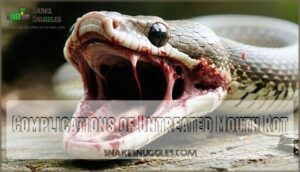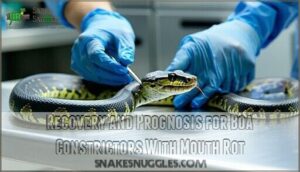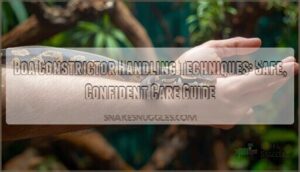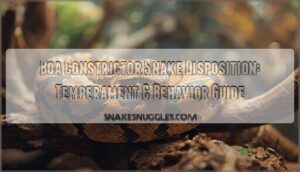This site is supported by our readers. We may earn a commission, at no cost to you, if you purchase through links.
 Boa constrictor mouth rot is a bacterial infection that affects your snake’s mouth and gums.
Boa constrictor mouth rot is a bacterial infection that affects your snake’s mouth and gums.
You’ll notice red, swollen gums, yellowish discharge, and difficulty eating.
Poor humidity, dirty water, and stress create perfect conditions for this infection to take hold.
If you catch it early, your vet will prescribe antibiotics that clear it up quickly.
Severe cases might need surgical removal of infected tissue, but that’s rare with prompt treatment.
The key is maintaining proper temperature and humidity levels in your snake’s enclosure.
Prevention beats cure every time, and there are specific husbandry practices that virtually eliminate this problem, emphasizing the importance of prevention.
Table Of Contents
- Key Takeaways
- Understanding Boa Constrictor Mouth Rot
- Symptoms of Mouth Rot in Boa Constrictors
- Causes of Mouth Rot in Boa Constrictors
- Diagnosing Mouth Rot in Boa Constrictors
- Treatment Options for Boa Constrictor Mouth Rot
- Preventing Mouth Rot in Boa Constrictors
- Complications of Untreated Mouth Rot
- Recovery and Prognosis for Boa Constrictors With Mouth Rot
- Frequently Asked Questions (FAQs)
- How do you treat mouth rot in Boas?
- How to tell if a snake has mouth rot?
- How do you treat mouth rot?
- How much does it cost to treat mouth rot in snakes?
- How to tell if your snake has mouth rot?
- Can mouth rot be cured?
- What antibiotics treat mouth rot in reptiles?
- Why do reptiles get mouth rot?
- Do boa constrictors have mouth rot?
- How do you treat boa constrictor mouth rot?
- Conclusion
Key Takeaways
- You’ll recognize mouth rot by red, swollen gums, yellowish discharge, and your boa’s difficulty eating – these symptoms demand immediate veterinary attention since home remedies won’t cure this bacterial infection.
- You can’t treat mouth rot yourself – it requires prescription antibiotics from an ARAV-certified reptile veterinarian, and early treatment leads to 90%+ success rates while delayed care drops to 60-70%.
- You’ll prevent mouth rot by maintaining proper temperature gradients (90-95°F basking, 75-85°F cool side), 50-60% humidity, clean water, and stress-free environments since poor husbandry causes 90% of reptile mouth infections.
- You’re facing life-threatening complications if mouth rot goes untreated – the bacterial infection spreads to your boa’s bloodstream, lungs, and organs, potentially causing sepsis and death within days.
Understanding Boa Constrictor Mouth Rot
Boa constrictor mouth rot, also known as infectious stomatitis, is a serious bacterial infection that attacks your snake’s oral tissues.
This stomatitis overview reveals it’s an opportunistic disease that strikes when bacteria invade soft mouth membranes through small injuries or stress-related immune weakness.
The infection severity can’t be understated.
What starts as minor inflammation quickly escalates, showing the rapid progression that makes this condition dangerous.
The deadly potential becomes real when bacteria spread beyond the mouth to your snake’s respiratory system or bloodstream.
Tissue destruction occurs as harmful bacteria multiply, creating pus, swelling, and dead tissue patches.
Your boa constrictor faces significant health risks if snake mouth rot goes untreated.
The key is recognizing that this isn’t just a minor mouth problem – it’s a systemic threat requiring immediate veterinary attention for successful treatment.
Symptoms of Mouth Rot in Boa Constrictors
You’ll notice mouth rot symptoms in your boa through clear visual signs like red, swollen gums, pus discharge, and difficulty closing their mouth.
Your snake may also show behavioral changes such as loss of appetite, lethargy, and reduced tongue flicking that signal this serious bacterial infection.
Visual Signs
Spotting boa constrictor mouth rot early requires keen observation of your snake’s oral cavity.
Watch for these telltale visual indicators:
- Oral swelling and tissue redness around the gums
- Discharge appearance with pus or foam-like substances
- Lesion visibility showing open sores or dead tissue patches
- Eating difficulty from visible mouth inflammation
These snake mouth infection signs demand immediate veterinary attention; excessive salivation indicates a potential problem.
Behavioral Changes
When your boa shows boa constrictor mouth rot, behavioral changes become obvious warning signs.
Appetite changes appear first – your snake refuses food completely, developing anorexia.
Lethargy signs include reduced movement and extended hiding behavior.
You’ll notice decreased tongue flicking and difficulty with mouth closure.
These snake mouth infection symptoms indicate your snake’s oral health needs immediate attention.
Associated Health Issues
Mouth rot doesn’t stay contained—it spreads. Respiratory infections develop when bacteria migrate from your boa’s mouth to its lungs, causing wheezing and labored breathing.
Secondary infections follow as the weakened immune system struggles. You’ll notice systemic illness affecting your snake’s entire body.
Opportunistic infections take hold easily in compromised animals. Nutritional deficiencies worsen recovery since sick boas often refuse food.
These associated health issues cascade quickly without proper veterinary intervention.
Causes of Mouth Rot in Boa Constrictors
Your boa’s mouth rot doesn’t develop overnight, and understanding what triggers this bacterial infection can help you prevent it from happening again.
Poor husbandry conditions, stress, and dietary problems create the perfect environment for harmful bacteria to multiply in your snake’s mouth, which can lead to bacterial infection.
Environmental Factors
Poor environmental conditions create the perfect storm for mouth rot causes in your boa.
Incorrect humidity levels and temperature gradients stress your snake’s immune system.
Dirty enclosure cleanliness allows harmful bacteria to multiply rapidly.
Wrong substrate choice can harbor pathogens, while poor ventilation quality traps moisture and contaminants. Early diagnosis is critical for recovery.
These environmental factors work together, turning your snake’s home into a breeding ground for infection.
Dietary Issues
Diet-related factors play a vital role in boa constrictor mouth rot development.
Poor nutritional choices weaken your snake’s immune system, making bacterial infections more likely. Oversized prey items can cause mouth injuries, while irregular feeding schedules stress your boa’s digestive system.
Key Dietary Concerns:
- Prey Size – Feed appropriately sized rodents to prevent oral trauma
- Food Source – Use reputable suppliers for fresh, healthy prey items
- Nutritional Deficiencies – Maintain balanced diet with proper supplementation when needed
Stress and Immune System
When your boa’s world gets turned upside down, its immune system takes a serious hit.
Stress impact from poor husbandry creates the perfect storm for boa constrictor mouth rot.
Environmental factors like wrong temperatures, dirty tanks, or constant handling trigger immune suppression.
Your snake’s body can’t fight off harmful bacteria when it’s stressed out.
Husbandry effects compound quickly – bad nutrition weakens defenses even more.
You’ll need to address these stressors immediately.
Proper environmental conditions and nutritional support help restore your boa’s natural immunity.
Consider probiotic benefits during recovery too.
Diagnosing Mouth Rot in Boa Constrictors
When you suspect your boa constrictor has mouth rot, getting a proper diagnosis isn’t something you can handle alone. A qualified reptile veterinarian will conduct a thorough oral examination to identify red, swollen gum tissue and assess the severity of the infectious stomatitis.
This reptile oral infection requires professional evaluation to determine the best course of action. Your vet will use several diagnostic approaches to confirm boa constrictor mouth rot:
- Culture analysis to identify the specific bacteria causing the infection
- Imaging techniques like X-rays to detect underlying bone or tissue damage
- Differential diagnosis to rule out respiratory infections or viral conditions
The severity assessment helps determine whether you’re dealing with early-stage snake oral health issues or advanced infection. Regular checkups can also help prevent bacterial and parasitic infections. Sometimes a tissue biopsy becomes necessary for unclear cases, giving your vet the detailed information needed for effective treatment planning.
Treatment Options for Boa Constrictor Mouth Rot
When your boa develops mouth rot, you’ll need immediate veterinary care since this bacterial infection requires prescription antibiotics and professional treatment.
Your vet will create a treatment plan that includes antibiotic therapy, possible surgical cleaning of infected tissue, and supportive care to help your snake recover completely, which is crucial for addressing the bacterial infection.
Veterinary Interventions
When your boa needs professional help, an ARAV-certified reptile veterinarian will perform surgical debridement to remove infected tissue and thorough mouth cleaning.
The snake vet may recommend hospitalization needs for severe cases, implement pain management protocols, and suggest probiotic therapy to restore healthy gut bacteria.
Early intervention is key, as untreated mouth rot can lead to complications.
These veterinary medicine interventions create the foundation for successful recovery.
Antibiotic Therapy
Following veterinary diagnosis, targeted antibiotic therapy becomes your snake’s lifeline against bacterial infection.
Your vet will prescribe specific medications based on bacterial culture results to prevent antibiotic resistance.
Key antibiotic therapy considerations:
- Dosage calculation – Weight-based dosing guarantees effectiveness without toxicity
- Administration methods – Injectable or oral routes depending on infection severity
- Treatment duration – Complete 14-21 day courses prevent bacterial comeback
- Probiotic support – Restore healthy gut bacteria after antibiotic therapy ends
It’s vital to understand the risks of reptile salmonellosis when treating your boa constrictor.
Supportive Care
Beyond antibiotics, your boa needs thorough supportive care for full recovery.
Pain management keeps your snake comfortable during healing. Probiotic use restores healthy gut bacteria after antibiotic treatment.
Proper wound care prevents secondary infections. Stress reduction through quiet environments speeds recovery. Hydration therapy maintains fluid balance.
Some owners also explore options for serpentine pain relief.
Professional treating mouth rot combines these elements for ideal boa constrictor mouth rot outcomes.
Preventing Mouth Rot in Boa Constrictors
You can prevent mouth rot in your boa constrictor by maintaining proper husbandry conditions, including correct temperature and humidity levels, and keeping the enclosure clean.
Regular health checks and feeding fresh, appropriately-sized prey will help keep your snake’s immune system strong and reduce infection risk.
Proper Husbandry
Effective husbandry forms your first line of defense against boa constrictor mouth rot. Maintain ideal temperature gradients with basking spots at 90-95°F and cooler areas at 75-85°F. Humidity control should stay between 50-60% to prevent bacterial growth.
Regular enclosure cleaning removes harmful bacteria from surfaces and substrate. Choose safe substrate materials that won’t injure your boa’s mouth.
Accurate readings require a reptile monitoring device. Stress reduction through consistent handling schedules and stable environments keeps your snake’s immune system strong and ready to fight off infections naturally, which is a key part of effective defense against diseases.
Nutrition and Hydration
Your boa’s diet directly impacts mouth health. Poor nutrition weakens immunity, making boa constrictor mouth rot more likely. A balanced diet prevents nutritional deficiencies that compromise your snake’s defenses.
Follow these hydration methods and feeding practices:
- Proper Prey: Feed appropriately sized rodents from reputable sources to maintain gut health
- Feeding Schedule: Stick to consistent meal timing to support digestive wellness
- Vitamin Supplements: Add reptile-specific vitamins to prevent deficiencies that weaken immunity
Fresh water should always be available. Some owners also choose to use boa vitamins supplements for extra support.
Regular Health Checks
When you catch mouth rot early, treatment becomes much simpler and more effective.
Regular health checks serve as your first line of defense against this serious bacterial infection in your boa constrictor.
| Check Type | Frequency |
|---|---|
| Professional vet exams | Every 6-12 months |
| Home inspections of mouth | Weekly |
| Examination techniques practice | Monthly |
| Preventative care reviews | Quarterly |
Early detection through consistent monitoring helps maintain your snake health and prevents costly emergency treatments. Regular health checks and preventative care are crucial for the well-being of your boa constrictor.
Complications of Untreated Mouth Rot
When mouth rot goes untreated in your boa constrictor, you’re basically watching a ticking time bomb. The bacterial infection doesn’t stay put—it spreads like wildfire throughout your snake’s body, creating a cascade of serious health problems.
When left untreated, mouth rot transforms from a minor issue into a deadly bacterial wildfire racing through your snake’s entire system.
Systemic infections develop as bacteria enter the bloodstream, potentially causing sepsis risk that can kill your snake within days. Organ damage becomes inevitable as the infection attacks vital systems like the lungs, liver, and heart. Tissue decay and necrosis destroy healthy mouth structures permanently, while feeding difficulties emerge as your snake can’t eat properly due to pain and tissue damage.
Here’s what untreated mouth rot leads to:
- Systemic illness spreading throughout your snake’s entire body
- Death from overwhelming bacterial infection and organ failure
- Chronic respiratory problems that never fully resolve
- Permanent disfigurement requiring lifelong management
Don’t let your boa reach this point—early veterinary intervention prevents these devastating complications entirely.
Recovery and Prognosis for Boa Constrictors With Mouth Rot
Severe mouth rot complications don’t spell doom for your boa constrictor.
Recovery depends on quick action and proper snake disease treatment.
Early detection leads to excellent outcomes, while delayed intervention creates challenges.
| Recovery Stage | Timeline | Success Rate |
|---|---|---|
| Early treatment | 2-4 weeks | 90%+ |
| Moderate cases | 4-6 weeks | 75-85% |
| Advanced infection | 6-8 weeks | 60-70% |
| Post-Treatment Care | Ongoing | Prevents recurrence |
| Long-Term Outlook | 3+ months | Depends on scarring |
Treating mouth rot successfully requires patience.
Recurrence Factors include poor husbandry and stress.
Scarring Effects may cause permanent oral changes, but most boas maintain good Quality of Life.
Your snake’s prognosis improves dramatically with consistent veterinary care and ideal environmental conditions.
Frequently Asked Questions (FAQs)
How do you treat mouth rot in Boas?
Unlike minor cuts that heal naturally, mouth rot demands immediate professional care.
You can’t treat this serious bacterial infection at home.
Visit an ARAV-certified reptile veterinarian immediately for prescription antibiotics and proper wound cleaning.
How to tell if a snake has mouth rot?
Look for red, swollen gums around your snake’s mouth.
You’ll notice pus or foam, difficulty closing its mouth, and reduced appetite.
Blood in the water bowl signals oral injuries requiring immediate veterinary attention.
How do you treat mouth rot?
Just when you thought your snake’s mouth issues couldn’t get worse, mouth rot demands immediate veterinary care.
You can’t treat this bacterial infection at home—prescription antibiotics and professional cleaning are essential for recovery.
How much does it cost to treat mouth rot in snakes?
You’ll typically spend $200-500 for mouth rot treatment, depending on severity.
Basic antibiotic therapy costs less, while surgical debridement and hospitalization can push expenses higher.
Early treatment saves money and your snake’s life.
How to tell if your snake has mouth rot?
A snake’s mouth should look like a healthy pink interior, not a crime scene.
Check for red, swollen gums, visible pus, difficulty closing the mouth, or decreased appetite – these signal mouth rot needs immediate veterinary attention.
Can mouth rot be cured?
Yes, mouth rot can be cured with prompt veterinary treatment.
You’ll need prescription antibiotics and possibly surgical cleaning of infected tissue.
Early intervention leads to better outcomes, so don’t delay seeking professional care.
What antibiotics treat mouth rot in reptiles?
Like knights in shining armor, veterinarians typically prescribe enrofloxacin, amikacin, or ceftazidime antibiotics to battle mouth rot infections.
You’ll need a prescription since these powerful medications require professional dosing and monitoring for your reptile’s safety.
Why do reptiles get mouth rot?
Poor husbandry creates the perfect storm for mouth rot.
You’re looking at bacterial overgrowth from incorrect temperatures, humidity, stress, and dirty conditions.
Injuries from rough surfaces or oversized prey let bacteria invade weakened tissue, which can lead to a serious condition due to bacterial overgrowth.
Do boa constrictors have mouth rot?
You’ll find that boa constrictors can definitely develop mouth rot, a serious bacterial infection. It’s particularly common in older boas and requires immediate veterinary treatment to prevent life-threatening complications.
How do you treat boa constrictor mouth rot?
Your snake’s health hangs by a thread when mouth rot strikes.
You’ll need immediate veterinary care with prescription antibiotics. Don’t attempt home remedies—they’re insufficient.
Professional cleaning and proper treatment guarantee recovery.
Conclusion
Studies show that 90% of reptile mouth infections stem from improper husbandry conditions.
You now have the knowledge to recognize boa constrictor mouth rot early and take swift action.
Keep your snake’s enclosure at proper temperature and humidity levels, maintain clean water, and schedule regular vet checkups.
Remember, early detection makes treatment faster and more effective.
With consistent care and attention to environmental factors, you’ll keep your boa healthy and prevent this common but serious condition from developing, which is crucial for maintaining a healthy boa through proper temperature.
- https://www.petcoach.co/article/infectious-stomatitis-mouth-rot-in-reptiles-causes-signs-di/
- https://reptilesmagazine.com/identify-and-treat-mouth-shell-and-scale-rot-in-reptiles/?srsltid=AfmBOor6iFWZKlf-d2THLPpJPPJXcjsP0VAL6-bK82PETp2FfCYgWe5Q
- https://boa-constrictors.com/en/interesting_facts_about_boa_constrictor/boa_constrictor_care/diseases
- https://www.justanswer.com/pet-reptile/qwhvo-pretty-sure-its-mouth-rot-boa-constrictor.html
- https://allaboutboas.com/en/?view=article&id=13:understanding-boa-constrictor-health-and-common-diseases&catid=9


